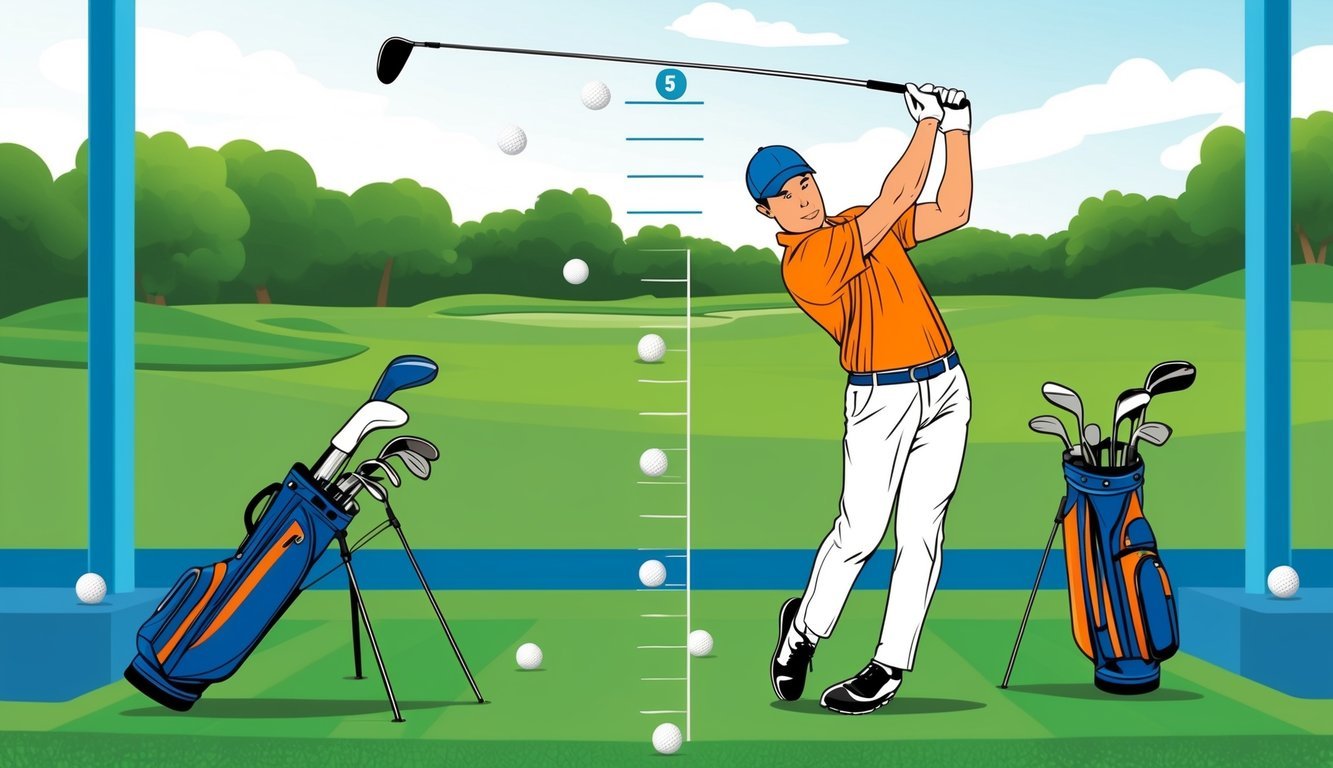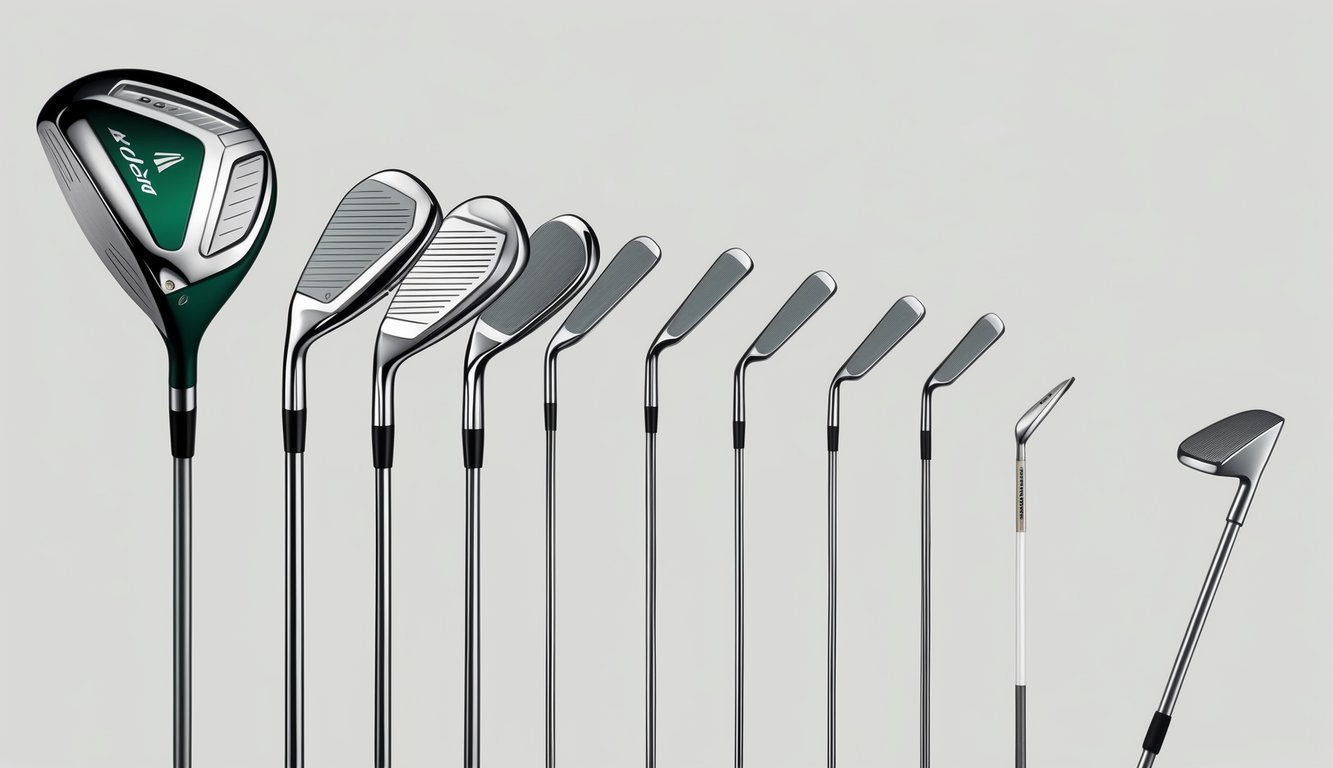Golf is a game of precision.
Understanding the average distance you can hit with each club is key to improving your performance. Male amateur golfers hit their drivers about 217 yards on average, while professional players can reach nearly 293.9 yards.
Knowing these distances allows you to make informed decisions on the course, maximizing your efficiency and reducing the number of strokes needed.

The variety of factors that influence your golf club distances includes your age, gender, skill level, and the type of clubs you use.
For example, senior golfers might see different average distances compared to younger or more experienced players.
By familiarizing yourself with these distinctions, you can better tailor your approach to meet your personal abilities and score better during your game.
Your equipment also plays a crucial role in how far you can send the ball flying.
Advancements in golf technology and equipment can assist in enhancing your distance, but focusing on improving technique and swing can lead to substantial gains too.
As you read on, you’ll discover strategies that can help you improve both your swing and equipment choices.
Key Takeaways
- Average golf club distances vary by player profile.
- Equipment and technology affect performance.
- Improving technique boosts your game.
Understanding Golf Club Distances
Golf club distances depend on various factors including swing speed, skill level, and the type of club used.
Different clubs, such as drivers or irons, offer varying yardages, and technology and practice can also enhance your performance.
Factors Affecting Distance
Several key elements play a role in how far you can hit a golf ball. Swing speed is crucial.
A faster swing typically results in greater distance, with the average PGA driver swing speed around 114 mph.
Meanwhile, amateurs often average closer to 90 mph.
The speed at which the ball is struck, known as ball speed, is equally important and affected by your club speed.
Your age, strength, and flexibility also influence distance.
Older golfers or those with less flexibility might achieve different results compared to younger, more agile players.
Skill level is another factor, as seasoned golfers often hit further due to experience and refined technique.
Additionally, technological advances in club design can provide a performance boost, enhancing distance for all skill levels.
Average Distance by Club Type
Different clubs contribute to varying average distances. Drivers, known for their long-range capabilities, can reach around 196 yards for seniors and up to 279 yards for PGA champions.
The 3 wood and 5 wood typically follow, providing slightly shorter distances.
For example, the average 3 wood distance might be around 173 yards for seniors and up to 240 yards for professionals.
Irons like the 7 iron generally cover 130 to 160 yards, depending on your swing and ability.
The 9 iron offers a shorter range, ideal for precision shots. Hybrids often fill the gap between woods and irons, while clubs like the lob wedge offer control for short-distance shots.
Understanding these averages helps in selecting the right club during play, ensuring accuracy and effectiveness on the course.
Golfer Profiles and Distances
Understanding the typical distances achieved by different golfer profiles can be useful for refining your game.
Before diving into the specifics, it’s important to note that distance can vary widely based on factors such as swing speed, skill levels, and physical ability.
PGA Tour Player Insights
PGA Tour players exhibit exceptional skill and typically achieve impressive distances.
The average PGA Tour player can often hit a driver over 290 yards.
They possess high swing speeds and refined techniques, allowing them to maximize distance and accuracy.
Their iron shots usually reach distances such as 150 yards with a 9-iron, thanks to precise control over club path and spin rate.
By studying how these athletes play, you can learn valuable tips to enhance your own golfing performance.
LPGA Tour Player Insights
LPGA Tour players also display remarkable distance capability, with some differences compared to their male counterparts.
You can expect an average LPGA Tour player to drive around 260 yards.
They excel in accuracy and finesse, often using these skills to outperform on courses that demand precision over brute force.
Their 7-iron shot averages about 160 yards, showcasing their ability to blend power with control.
Observing LPGA Tour players can help you appreciate the alternative strengths of precision and technique in golf.
Senior and Junior Golfers
Senior and junior golfers have unique distance profiles due to varying physical capabilities.
Senior golfers may hit slightly shorter than younger counterparts, often driving around 200 to 220 yards with drivers.
With clubs like the 7-iron, they might reach distances of about 130 yards, emphasizing precision over power.
For juniors or young golfers, distances can considerably vary based on age and experience.
Their focus often leans more on learning techniques and gaining control, gradually building power and distance as their skills develop.
Understanding these profiles helps you tailor your approach to golf, appreciating that every stage of life offers different strengths and challenges in the game.
Equipment and Technology

Understanding the technology behind your golf equipment can enhance your game significantly.
Selecting suitable clubs and the right golf balls is crucial for achieving optimal performance.
Choosing the Right Clubs
Selecting the right clubs is essential for improving your game.
When choosing, consider factors like the loft and the distance covered.
A golf club distance chart can help you understand how far each club typically hits.
This aids in selecting the club that best suits your swing speed and course strategy.
Using tools like a launch monitor or Trackman provides insights into the smash factor, launch angle, and spin rate.
These technologies help you find the club’s sweet spot and improve accuracy.
Weather conditions and altitude also affect performance, so adjust your selection based on these variables for consistent results.
Golf Ball Selection
The choice of golf ball can significantly influence your game by affecting distance, spin, and control.
Golf balls vary in compression and construction, impacting how they interact with the club upon impact.
Weather conditions, such as wind and humidity, can also affect how far the ball travels.
Consider the spin rate, which determines the ball’s behavior in the air and on the green.
A higher spin rate can provide more control but might reduce distance.
Additionally, assess how altitude affects your shots since higher elevations can result in longer distances.
Testing different ball types that suit your style of play will lead to more consistent performance.
Improving Your Distance

Enhancing your golf club distance involves refining specific skills through consistent practice and maintaining physical fitness.
Both technique and physical condition play a crucial role in achieving longer shots and improving overall performance.
Practice Routines
Regular practice is essential for improving energy transfer and swing speeds.
Focus on developing a consistent practice routine that targets different aspects of your game.
Start by dedicating sessions to work on swing mechanics, ensuring that each movement is fluid and enhances ball flight.
Use drills designed to increase clubhead speed.
Try incorporating exercises that focus on the tempo of your swing.
These can help in building muscle memory, leading to more confidence during actual gameplay.
Recording your swings and analyzing them can provide valuable insights into areas that need improvement.
Physical Fitness and Training
Physical fitness plays a vital role in improving distance.
Focus on strength and flexibility to enhance energy transfer during your swing.
Exercises like weightlifting and resistance training can build the muscle needed for powerful swings.
Incorporate flexibility exercises such as yoga or Pilates.
These can improve your range of motion, allowing for smoother swings and increased swing speeds.
Regular cardiovascular workouts can boost stamina, helping maintain consistency throughout a game.
Engaging in a comprehensive fitness plan tailored to your needs can significantly impact your golfing performance.
Factors Beyond the Swing

Golf performance is influenced by a range of factors beyond just the mechanics of your swing.
Environmental conditions and your mental attitude both play significant roles in determining how well you can play.
Environmental Influences
Weather factors like wind, temperature, and humidity can make a huge difference in your game.
Wind can either aid or hinder your ball’s trajectory.
A strong tailwind might add yards, while a headwind can result in shots falling short.
Temperature also plays a role.
Cold weather can decrease ball distance as the ball tends to not compress as well, impacting energy transfer.
Conversely, warmer temperatures can enhance distance, as the ball retains more elasticity and velocity.
Humidity affects air density.
Higher humidity can decrease air density, allowing the ball to travel further, while low humidity can lead to shorter distances.
Paying attention to these environmental conditions can help you make more accurate shots and strategic decisions on the golf course.
Mental Game and Confidence
Confidence and your mental game are key factors in your golf performance.
Your mentality can significantly influence how you approach each shot.
A positive mindset helps in dealing with challenging conditions, adapting your strategy as needed.
Confidence grows with practice and familiarity with your equipment and the course.
Feeling assured allows you to commit to shots and minimize errors.
Meanwhile, energy levels are also vital, as they can affect concentration and endurance over a long game.
Practices like visualization can improve focus and build self-assurance.
A strong mental game means better decision-making, leading to more accurate and controlled strokes.

